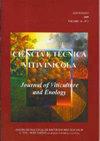Strategies for the improvement of fruit set in vitis vinifera L. Cv. 'carménère' through different foliar biostimulants in two different locations
IF 1.1
4区 农林科学
Q4 FOOD SCIENCE & TECHNOLOGY
引用次数: 11
Abstract
‘Carmenere’ is an important grapevine variety cultivated in Chile, which exhibits a high tendency to fruitlet abscission and “millerandage”, reproductive disorders that seriously affect plant productivity. However, despite the existence of a lot of information about the effects of micronutrients on millerandage, few studies exist about the impacts of seaweed biostimulation on reproductive disorders in grapevines, which currently has been classified as elicitor. For these reasons, the aim of this work was to study the effect of different biostimulant applications to ‘Carmenere’ grapevines on fruit set and cluster characteristics during 2011-2012 season. Viticultural parameters such as number and weight of berries, cluster weight, berry size and its distribution along the cluster were measured. In addition, physicochemical parameters in musts from the obtained grapevines were analyzed. The results showed that the treatments based on boron ethanolamine plus zinc oxide and brown algae (Ascophyllum nodosum ) improved fruit set in ‘Carmenere’ grapevines in both climate locations, mainly in the colder climate site. Different parameters such as weight and number of berries per bunch, among others, were improved after the application of this treatment. Therefore, the results suggest that it is possible to improve fruit set in ‘Carmenere’ grapevines using a treatment based on certain microelements, such as boron and zinc, and an extract produced from seaweed algae.葡萄坐果品质的改良策略。在两个不同的位置通过不同的叶面生物刺激剂来进行“carmsamuire”
' Carmenere '是智利栽培的一个重要葡萄品种,它表现出高的果实脱落倾向和“千年虫”,严重影响植物生产力的生殖障碍。然而,尽管关于微量营养素对植株生长的影响已有大量的研究,但关于海藻生物刺激对葡萄藤生殖障碍的影响的研究很少,目前将其归类为促发剂。基于这些原因,本研究的目的是研究2011-2012年不同生物刺激素对“Carmenere”葡萄的结实和集群特性的影响。测定了果实的数量和重量、簇重、果实大小及其沿簇分布等葡萄栽培参数。此外,还分析了所得葡萄的理化参数。结果表明,以硼乙醇胺加氧化锌和褐藻(Ascophyllum nodosum)为基础的处理提高了两个气候地点的‘Carmenere’葡萄的坐果率,主要是在寒冷气候地点。不同的参数,如每串浆果的重量和数量等,在应用该处理后得到改善。因此,研究结果表明,使用基于某些微量元素(如硼和锌)和从海藻中提取的提取物的处理,有可能改善“Carmenere”葡萄藤的结实程度。
本文章由计算机程序翻译,如有差异,请以英文原文为准。
求助全文
约1分钟内获得全文
求助全文
来源期刊

Ciencia E Tecnica Vitivinicola
Agricultural and Biological Sciences-Food Science
自引率
12.50%
发文量
5
期刊介绍:
Ciência e Técnica Vitivinícola (Journal of Viticulture and Enology) is an international journal that publishes original articles, research notes and review articles, written in Portuguese or in English, on the various fields of the science and technology of vine and wine: Viticulture, Enology and Vitivinicultural economy.
 求助内容:
求助内容: 应助结果提醒方式:
应助结果提醒方式:


